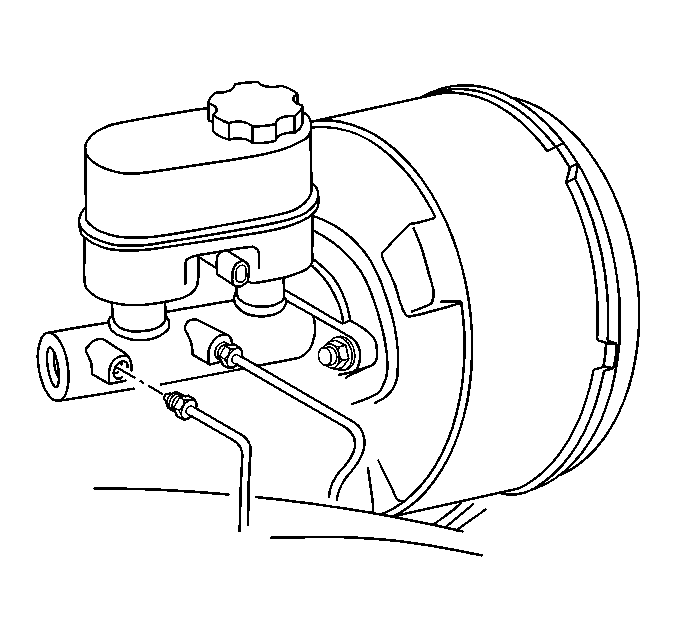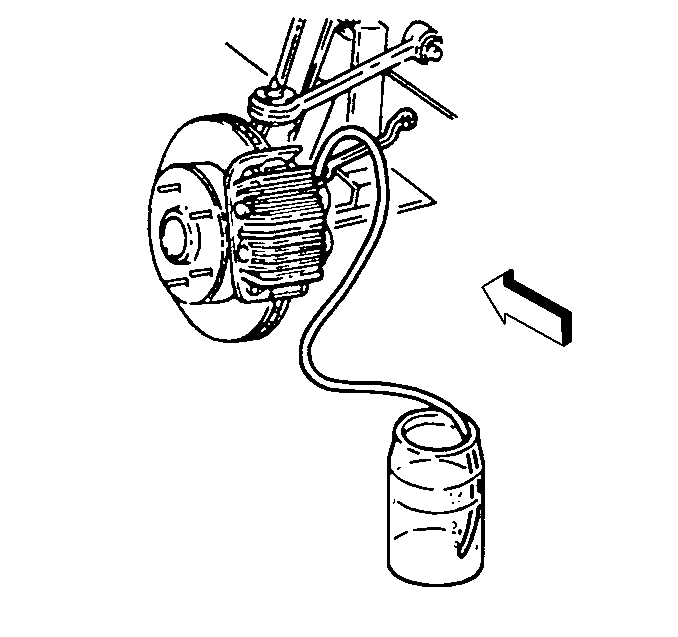The time required to bleed the hydraulic system can be
reduced if the master cylinder reservoir is filled with brake fluid and as
much air as possible is expelled before the master cylinder is installed on
the vehicle. Pumping the piston can evacuate the air from the piston cavities.
Power brakes require the vacuum reserve be depleted by applying the
brakes several items with the engine off. Care must be taken to prevent brake
fluid from contacting any painted surface.

- Fill the master cylinder reservoir with brake fluid and keep the reservoir
at least half full of fluid during the bleeding operation.
- If the master cylinder is known or suspected to have air in the
bore, then it must be bled in the following manner, before bleeding any caliper:
| 2.1. | Disconnect the forward (blind end) brake pipe connection at the
master cylinder. |
| 2.2. | Allow the brake fluid to fill the master cylinder piston bore
until it begins to flow from the forward pipe connector port. |
| 2.3. | Connect the forward brake pipe to the master cylinder and tighten. |
| 2.4. | Depress the brake pedal slowly one time and hold. Loosen the
forward brake pipe connection at the master cylinder to purge air from the
bore. Tighten the connection and then release the brake pedal slowly. Wait
15 seconds. Repeat the sequence, including the 15 second wait, until all
air is removed from the bore. |
Tighten
Tighten the brake pipe tube nut to 16 N·m (12 lb ft).
Notice: Use the correct fastener in the correct location. Replacement fasteners
must be the correct part number for that application. Fasteners requiring
replacement or fasteners requiring the use of thread locking compound or sealant
are identified in the service procedure. Do not use paints, lubricants, or
corrosion inhibitors on fasteners or fastener joint surfaces unless specified.
These coatings affect fastener torque and joint clamping force and may damage
the fastener. Use the correct tightening sequence and specifications when
installing fasteners in order to avoid damage to parts and systems.
| 2.5. | When clear fluid flows from the forward connection, repeat Steps
1 and 2 to bleed the master cylinder at the rear (cowl) connection. |

- Individual brake calipers are bled only after all air is removed from the
master cylinder. If it is known that the brake calipers do not contain any
air, then it will not be necessary to bleed them.
| 3.1. | Place a proper size box end wrench, or equivalent, over the brake
caliper bleed screw. Attach a clear tube over the screw. Submerge the other
end of the tube in a clear container partially filled with brake fluid. |
| 3.2. | Depress the brake pedal slowly one time and hold. Loosen the
brake caliper bleed screw to purge the air from the cylinder. Tighten the
brake caliper bleed screw and slowly release the pedal. Wait 15 seconds.
Repeat the sequence, including the 15 second wait, until all air is removed.
It may be necessary to repeat the sequence 10 or more times to remove all
the air. Rapid pumping of the brake pedal pushes the master cylinder secondary
piston down the bore in a way that makes it difficult to bleed the system. |
Tighten
Tighten the brake caliper bleed screws to 12N·m (106 lb in).
| 3.3. | If it is necessary to bleed all of the brake calipers, the following
sequence should be used: |
| 3.4. | Check the brake pedal for sponginess. |


